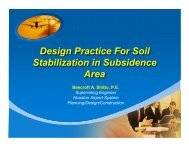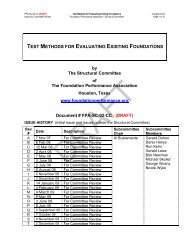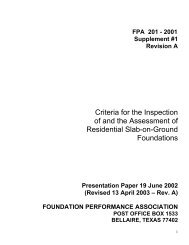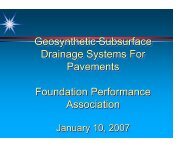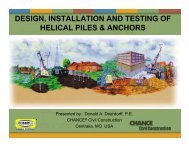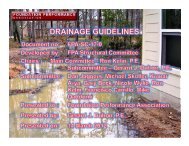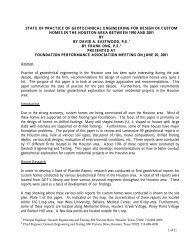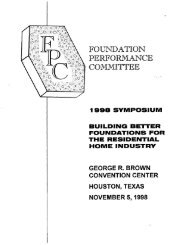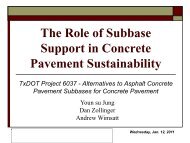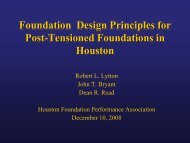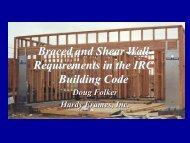Soil-Structure Interaction Seminar - Foundation Performance ...
Soil-Structure Interaction Seminar - Foundation Performance ...
Soil-Structure Interaction Seminar - Foundation Performance ...
You also want an ePaper? Increase the reach of your titles
YUMPU automatically turns print PDFs into web optimized ePapers that Google loves.
FOUNDATION REPAIR TECHNIQUES PAGE 7 OF 7<br />
PIPE TRENCHES<br />
20) Pipe trenches have traditionally been installed using bank sand as the backfill material. Sand<br />
is dumped into the open trench and water-compacted to achieve the necessary Proctor density.<br />
Sometimes these same pipe trenches become a channel for transmitting excessive water into the<br />
interior of the building, and heaving of the clay soils and cracking of the interior finish materials<br />
may result. Although seldom addressed by structural engineers, care should be taken to specify<br />
that the· ends of pipe trenches be sealed off at the perimeter of the foundations. Suggested<br />
corrections to existing problems of this type include: water barriers, clay fill, French drains,<br />
polyurethane injection or other methods.<br />
CHECKING TENDON STRESSES<br />
21) How do we know if post-tensioned tendons have been stressed? A clue to stressing not<br />
having been done is an unusually high incidence of shrinkage cracks, especially on the sides of<br />
the exterior grade beams. Chipping out at least two live end anchorages on each side and<br />
inspecting the shims, one can see if they are properly seated or not. If it is not clear whether or<br />
not they are, then the tendons should be tensioned to 25 to 50% of the maximum design stress<br />
using a calibrated hydraulic ram jack. If the shims do become not unseated, it may be assumed<br />
that at least a percentage of the design tensile force is present. We do not recommend that the<br />
full design force be applied, since should the gripping shims slip, the cable end may end up<br />
several inches inside the grade beam and very costly structural repairs would then be required.<br />
SOIL STABILIZATION<br />
22) Available soil stabilization methods for existing buildings:<br />
a) Condor SS injection (an ionization treatment for clays)<br />
b) Lime injection<br />
c) Water barriers<br />
d) Polyurethane injection<br />
e) Improved moisture control using deep sump pumps<br />
f) Barriers at pipe trench entrances to foundation system<br />
g) "Leaky pipe" systems<br />
------------- end -------------<br />
-·



